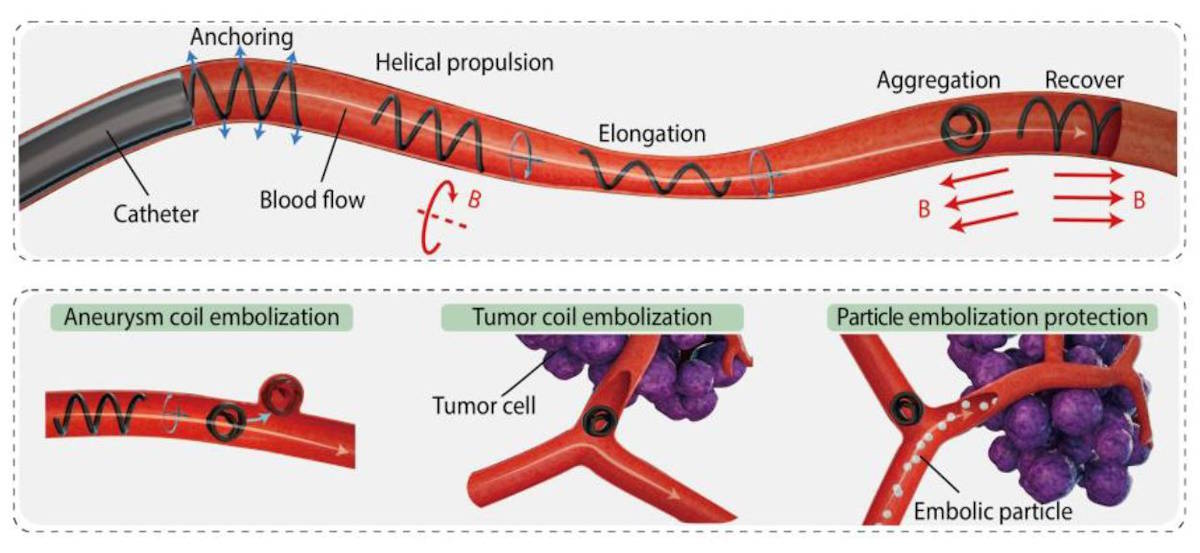Magnetic microbots show promise for treating aneurysms and brain tumours
14 Mar 2024
Remote control Schematic showing (top panel) how microfibrebots can anchor to a blood vessel, navigate via helical propulsion, elongate to pass through narrow regions and aggregate to block blood flow. Potential applications (bottom panel) include coil embolization of aneurysms and tumours, and selective particle embolization of tumours. (Courtesy: Jianfeng Zang, HUST)
A team of researchers in China has developed novel magnetic coiling “microfibrebots” and used them to embolize arterial bleeding in a rabbit – paving the way for a range of controllable and less invasive treatments for aneurysms and brain tumours.
When attempting to stop bleeding in aneurysms or stem the flow of blood to brain tumours (a process known as embolization), surgeons generally run a slim catheter through the femoral artery and navigate it through blood vessels to deliver embolic agents. Although widely used, these catheters are difficult to guide through complex vascular networks.
In an effort to address this challenge, a team of researchers at Huazhong University of Science and Technology (HUST) created tiny magnetic, soft microfibrebots that can carry out such procedures remotely. The devices, made from a magnetized fibre twisted into a helix shape, can fit a range of different vessel sizes and move along in a corkscrew fashion when exposed to an external magnetic field. The results of the research, presented in Science Robotics, demonstrate how the devices were successfully used to stem arterial bleeding in a rabbit.
As co-author Jianfeng Zang explains, the microfibrebots are made by using thermal energy to draw magnetic soft composite materials into microfibres, which are then “magnetized and moulded to give them helical magnetic polarity”. By controlling the magnetic field, the magnetic soft microfibre robot demonstrated reversible morphological transformation (elongation or aggregation) and spiral propulsion through blood flow (both upstream and downstream). This allows it to be navigated through complex vascular systems and perform robotic embolization in the sub-millimetre region.
“The article shows how we performed in vitro embolization of aneurysms and tumours in a neurovascular model, and performed robotic navigation and embolization under real-time fluoroscopy in an in vivo rabbit femoral artery model,” says Zang. “These experiments demonstrate the potential clinical value of this work and pave the way for future robot-assisted embolization surgical options.”
Anchoring function
According to first author Xurui Liu, a PhD student at HUST, each microfibrebot possesses an anchoring function, similar to that of a vascular stent, enabling it to be stably anchored to the inner wall of blood vessels through contact friction to avoid being washed away by the blood flow.
“Its helical magnetization distribution provides the microfibre robot with a net magnetization direction along its central axis. By applying an external magnetic field consistent with the direction of the net magnetization direction, the robot can be elongated,” she says.
“Conversely, when the external magnetic field is opposite to the direction of net magnetization, the robot will gather,” she adds. “The softness and high robustness of this microfibre robot ensures that its morphological reconstruction function remains fully reversible after more than a thousand aggregation and elongation cycles.”
Promising alternative
In contrast to the magnetic soft robots reported in earlier research, Zang confirms that the helical magnetization direction characteristics of the new robots enable their deformation and movement modes to be orthogonally decoupled independently of the control magnetic field, providing “unique magnetic field control flexibility”.
“This feature not only allows a single microfibre robot to move at high speed against the blood flow under the action of a rotating magnetic field, but also enables independent control of the shape and movement of multiple microfibrebots,” Zang explains.
“Additionally, these devices are compatible with commonly used interventional catheters to maximize their potential for use in clinical settings,” he adds.
Faced with the challenges of traditional methods such as catheter-based embolization – particularly in terms of their operational limitations and insufficient precision, as well as the health risks related to doctors being exposed to radiation for long periods of time (from the X-ray guidance system) – Zang points out that the development of magnetic microfibrebot technology provides clinicians with a new means of improving existing treatments.READ MORE

“The development of microfibrebots provides a new perspective for vascular embolization treatment and shows application potential in minimally invasive surgical treatment technology. This technology provides an effective complement or alternative to traditional catheter embolization technology by precisely controlling blood flow occlusion,” he says.
Zang notes that while this technology shows potential, there are still challenges to overcome prior to its clinical application. These include structural optimization of microfibrebots, increasing the biocompatibility of materials, and development of blood vessel positioning and tracking systems. “The research team is working to address these key issues to advance the application of the technology,” he adds.
FROM PHYSICSWORLD.COM 21/3/2024

Δεν υπάρχουν σχόλια:
Δημοσίευση σχολίου